Items
Tag
costume
-
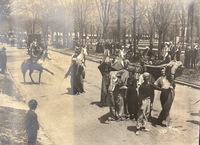 Elephants at "Parade Rest" Taken from the Kapp scrapbook, this image is inscribed with "Lyndon. 1133" and captioned with sentence "Elephants at 'Parade Rest'". It depicts the Union Circus parade, temporarily paused next to the university campus. White students clad in blackface perform various roles as either elephant trainer or indigenous person. Their costumes depict stereotypes of native peoples and of South Asians. Circus goers watch with interest from the sidelines. The Ann Arbor trolly tracks can be seen along the grass.
Elephants at "Parade Rest" Taken from the Kapp scrapbook, this image is inscribed with "Lyndon. 1133" and captioned with sentence "Elephants at 'Parade Rest'". It depicts the Union Circus parade, temporarily paused next to the university campus. White students clad in blackface perform various roles as either elephant trainer or indigenous person. Their costumes depict stereotypes of native peoples and of South Asians. Circus goers watch with interest from the sidelines. The Ann Arbor trolly tracks can be seen along the grass. -
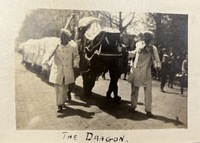 The Dragon The image is inscribed "THE DRAGON". As part of the Union Circus' parade, students constructed a long dragon costume to walk down State Street. The guides, both white men, wear a potentially Asian-inspired outfit and some form of blackface. Though unclear, it's probable these students are mimicking Asian men.
The Dragon The image is inscribed "THE DRAGON". As part of the Union Circus' parade, students constructed a long dragon costume to walk down State Street. The guides, both white men, wear a potentially Asian-inspired outfit and some form of blackface. Though unclear, it's probable these students are mimicking Asian men. -
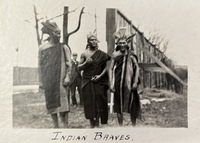 Indian Braves Three white men, costumed as stereotypical Native Americans, wear thin gowns and feathered headdresses. Additionally, the men are covered in brown makeup to mimic some Indigenous skin tones. The photograph is inscribed "INDIAN BRAVES". It's likely these men are part of the Union Circus' "Michigamua Indians" student group. Importantly, all members of this group were white men.
Indian Braves Three white men, costumed as stereotypical Native Americans, wear thin gowns and feathered headdresses. Additionally, the men are covered in brown makeup to mimic some Indigenous skin tones. The photograph is inscribed "INDIAN BRAVES". It's likely these men are part of the Union Circus' "Michigamua Indians" student group. Importantly, all members of this group were white men. -
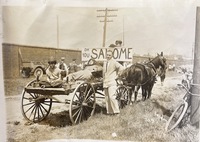 Oh You Salome Found within the Frank Kapp scrapbook, this image displays two children and two men, one wearing a woman's dress, resting on a Union Circus wagon. A sign reading "Oh You Salome" sits in the center of the group, identifying the men as part of the titular side show performance. Beneath the image is the inscription "Oh you kid!!!". The performance may be anti-Semitic in nature. The Biblical Salome was a Jewish princess often blamed for the murder of John the Baptist. Several plays and operatic productions about Salome were popular prior to 1909.
Oh You Salome Found within the Frank Kapp scrapbook, this image displays two children and two men, one wearing a woman's dress, resting on a Union Circus wagon. A sign reading "Oh You Salome" sits in the center of the group, identifying the men as part of the titular side show performance. Beneath the image is the inscription "Oh you kid!!!". The performance may be anti-Semitic in nature. The Biblical Salome was a Jewish princess often blamed for the murder of John the Baptist. Several plays and operatic productions about Salome were popular prior to 1909. -
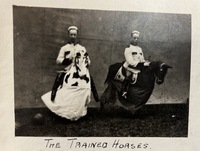 The Trained Horses "THE TRAINED HORSES", as the inscription reads, are two students dressed as both horse and rider. This performers were two of many people costumed as animals in the Union Circus.
The Trained Horses "THE TRAINED HORSES", as the inscription reads, are two students dressed as both horse and rider. This performers were two of many people costumed as animals in the Union Circus. -
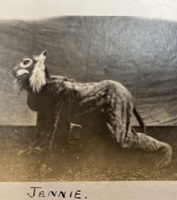 The Union Circus "Tiger" The inscription accompanying this image reads "JENNIE". The name may refer to either the student dressed as a tiger or the tiger character itself. This performer was one of many costumed as an animal in the Union Circus.
The Union Circus "Tiger" The inscription accompanying this image reads "JENNIE". The name may refer to either the student dressed as a tiger or the tiger character itself. This performer was one of many costumed as an animal in the Union Circus. -
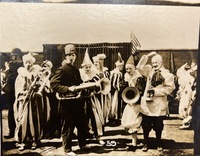 A Bunch of Clowns The popularity of brass bands at the beginning of the 20th century is made evident by this image of musical performers in the Union Circus. The band, clad in clown costumes and police uniforms, holds a variety of instruments, including: trumpets, trombones, and tubas. The group of more than 12 men appears to be waiting for their performance to begin. The inscription below the photograph reads "A Bunch of Clowns"
A Bunch of Clowns The popularity of brass bands at the beginning of the 20th century is made evident by this image of musical performers in the Union Circus. The band, clad in clown costumes and police uniforms, holds a variety of instruments, including: trumpets, trombones, and tubas. The group of more than 12 men appears to be waiting for their performance to begin. The inscription below the photograph reads "A Bunch of Clowns" -
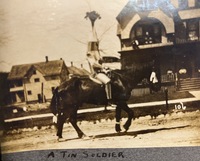 A Tin Soldier A student in the Union Circus dubbed "A Tin Soldier" by the inscription under the image, trots through Ann Arbor on his dark horse. He is costumed from head to toe in metal material to appear as a knight. A large plum sticks up from the top of his helmet. Based on the circus' known parade route, the location the image was taken is likely along State Street.
A Tin Soldier A student in the Union Circus dubbed "A Tin Soldier" by the inscription under the image, trots through Ann Arbor on his dark horse. He is costumed from head to toe in metal material to appear as a knight. A large plum sticks up from the top of his helmet. Based on the circus' known parade route, the location the image was taken is likely along State Street. -
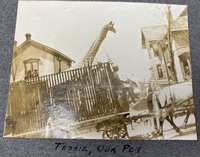 Tessie, Our Pet In lieu of real exotic animals, students crafted replicas for actors to wear during the parade. A giraffe, named "Tessie" according to the image's description, was a highlight of the event. One image shows the costumed students being driven downtown in a caged wagon, while the other shows the students stationed somewhere, possibly Ferry Field, with another student.
Tessie, Our Pet In lieu of real exotic animals, students crafted replicas for actors to wear during the parade. A giraffe, named "Tessie" according to the image's description, was a highlight of the event. One image shows the costumed students being driven downtown in a caged wagon, while the other shows the students stationed somewhere, possibly Ferry Field, with another student. -
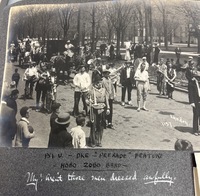 My! Aren't those men dressed awfully? This photo was found in the scrapbook of former University of Michigan student, Stowell Stebbins. The image was inscribed "PSI U. - DKE - "Peerade" Feature - Hobo Zobo Band" and "My! Aren't those men dressed awfully." Young boys watch from the sideline as men dressed as "hobos" walk down the unpaved street with marching band instruments. Some of these white men showcase fake stubble, while others appear to be painted in blackface. Horses, carriages, clowns, and knights are also part of the procession.
My! Aren't those men dressed awfully? This photo was found in the scrapbook of former University of Michigan student, Stowell Stebbins. The image was inscribed "PSI U. - DKE - "Peerade" Feature - Hobo Zobo Band" and "My! Aren't those men dressed awfully." Young boys watch from the sideline as men dressed as "hobos" walk down the unpaved street with marching band instruments. Some of these white men showcase fake stubble, while others appear to be painted in blackface. Horses, carriages, clowns, and knights are also part of the procession. -
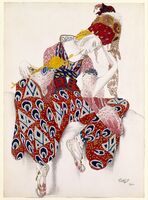 Costume Study for Vaslav Nijinsky in the Role of Iksender in the Ballet "La Péri" (The Flower of Immortality)
Costume Study for Vaslav Nijinsky in the Role of Iksender in the Ballet "La Péri" (The Flower of Immortality)